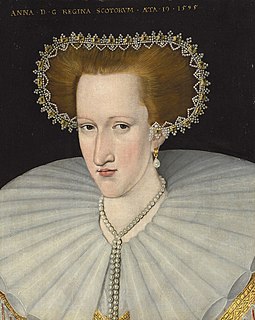Related Research Articles

Tynemouth Castle is located on a rocky headland, overlooking Tynemouth Pier. The moated castle-towers, gatehouse and keep are combined with the ruins of the Benedictine priory where early kings of Northumbria were buried. The coat of arms of the town of Tynemouth still includes three crowns commemorating the tradition that the Priory had been the burial place for three kings.

John Erskine, Earl of Mar was a Scottish politician, the only son of another John Erskine and Annabella Murray. He is regarded as both the 19th earl and the 2nd earl.

George Home, 1st Earl of Dunbar, KG, PC was, in the last decade of his life, the most prominent and most influential Scotsman in England. His work lay in the King's Household and in the control of the State Affairs of Scotland and he was the King's chief Scottish advisor. With the full backing and trust of King James he travelled regularly from London to Edinburgh via Berwick-upon-Tweed.
The Selby family is a prominent and prolific family in the English gentry that originated in Selby, Yorkshire, but largely settled in Northumberland and County Durham. At various points through history, the family owned Biddlestone Hall and Twizell Castle in Northumberland in addition to the manor houses Ightham Mote in Kent and at Beal, Northumberland. The family had two baronetcies; the Selby and the Selby-Bigge but both are now extinct.
The Hostmen of Newcastle upon Tyne were a cartel of businessmen who formed a monopoly to control the export of coal from the River Tyne in North East England. They were so known from the medieval practice of "hosting", whereby local businessmen provided visiting merchants with accommodation and introduced them to local traders. The Hostmen acted as middlemen with whom the coal producers and those who shipped the coal to London and elsewhere were forced to deal.
Sir John Spilman was a Lindau, German-born entrepreneur who founded the first commercially successful paper-mill in England, establishing a factory on the River Darenth in Dartford, Kent in 1588. Spilman was also jeweller to Queen Elizabeth I, and was knighted by King James I.
Captain Sir Thomas Liddell, 1st Baronet (1578–1652) was an English politician, a member of the Liddell family which monopolized the local government of the North of England during the 16th and 17th centuries. He was one of the leading supporters of the Royalist cause in the English Civil War.
Sir David Foulis was a Scottish politician.
Sir Richard Cockburn of Clerkington, Lord Clerkintoun (1565–1627) was a senior government official in Scotland serving as Lord Privy Seal of Scotland during the reign of James VI.
Sir William Herrick was an English jeweller, courtier, diplomat and politician who sat in the House of Commons at various times between 1601 and 1622.
Sir William Selby was an English politician who sat in the House of Commons from 1597 to 1601.
Thomas Foulis was a Scottish goldsmith, mine entrepreneur, and royal financier.
Margaret Hartsyde was a Scottish servant, jewel thief, and landowner. A servant of the queen, Anne of Denmark, Hartsyde's duties included looking after the queen's jewels, dealing with the jeweller George Heriot, and handling large sums of money.

The Great 'H' of Scotland was a jewel belonging to Mary, Queen of Scots. It was broken up in 1604 and made into the Mirror of Great Britain for James VI and I.
Annabell Murray, Countess of Mar (1536–1603), was a Scottish landowner, courtier and royal servant, the keeper of the infant James VI and his son Prince Henry at Stirling Castle

Dr Martin Schöner or Schönerus, physician to James VI and I and Anne of Denmark
William Selby, was an English member of parliament and soldier at Berwick upon Tweed.

Jacob Kroger, was a German goldsmith who worked for Anne of Denmark in Scotland and stole her jewels.

Alexander Elphinstone, 4th Lord Elphinstone (1552-1638), was a Scottish courtier, landowner, and Lord Treasurer
Sir John Selby of Twizell was an English landowner and border official.
References
- 1 2 History of Parliament Online - George Selby
- ↑ 'Tynemouth', Proceedings of the Society of Antiquaries of Newcastle, vol. 10 no. 24 (1902), p. 285: HMC 6th Report (Northumberland) (London, 1877), p. 232.
- ↑ Calendar of State Papers Scotland, vol. 11 (Edinburgh, 1936), pp. 339, 342-3, 356-7.
- ↑ Proceedings of the Society of Antiquaries of Newcastle, vol. 10 (1902), p. 285: HMC 6th Report (Northumberland) (London, 1877), p. 232.
- ↑ Border Papers, vol. 1 (Edinburgh, 1894), pp. 538-9.
- ↑ Richard Welford, History of Newcastle and Gateshead, vol. 3 (London, 1887), p. 90.
- 1 2 3 C H Hunter Blair The Sheriffs of Northumberland Archaeologia Aeliana: Or, Miscellaneous Tracts Relating to Antiquities
- ↑ John Nichols, Progresses of James the First, vol. 3 (London, 1828), pp. 280-1.
- ↑ John Nichols, Progresses of James the First, vol. 3 (London, 1828), pp. 280-1.
| Parliament of England | ||
|---|---|---|
| Preceded by | Member of Parliament for Newcastle-upon-Tyne 1601–1611 | Succeeded by |